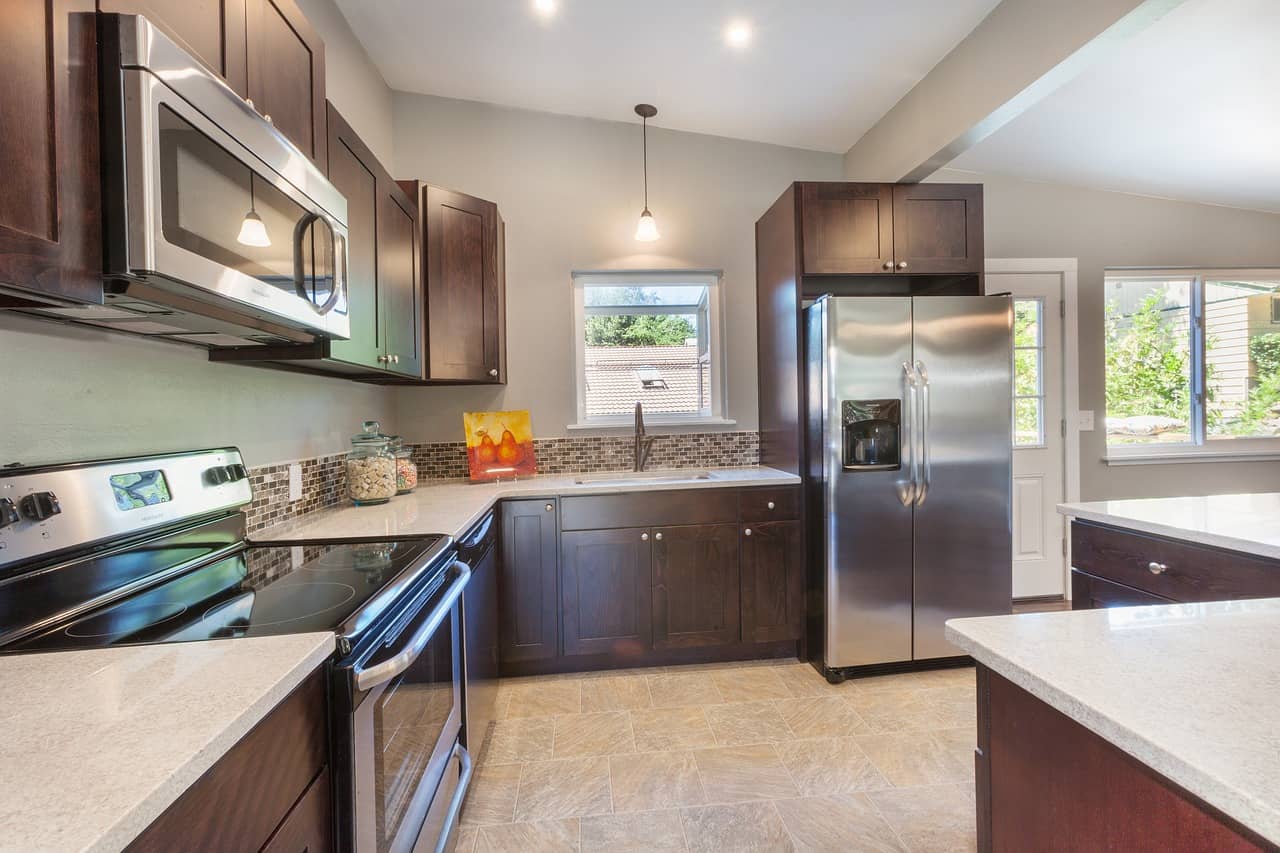Quartz is undoubtedly one of the most popular materials to feature in kitchens and bathrooms across the United States today.
It ranks highly for three important factors: durability, beauty, and is completely low-maintenance. Seriously, what more could you ask for in two of the most high-traffic areas in your home?
If you’re looking to install quartz countertops in either a kitchen or bathroom, this guide should help you make the best possible choice for your home…
What is Quartz?
Quartz is an engineered material, comprised of ground quartz, bound with polyester resin to make it a hardy surface material.
Some of the top benefits of quartz are that it’s a non-porous, anti-microbial material that won’t hold onto germs, stains, and odors.
The only downside is that quartz is highly susceptible to intense sunlight and the color can fade over time. This is why it’s best used as an indoor surface material. Keep in mind that outdoor use may invalidate any warranty on your quartz countertops.
For a few extra facts you didn’t know about quartz, read more here.
Why is Quartz So Popular?
So, what is the buzz around quartz anyway? One of the main reasons why quartz has stormed today’s home renovation market is the fact that it’s so affordable.
Other than its reasonable price, quartz is also extremely versatile. It comes in a wide range of colors, patterns, and textures to match almost any color scheme in your home.
It’s also exceptionally low-maintenance as it’s perma-sealed during production, which makes it highly durable. Quartz offers the elegance of natural stone, despite the fact that it’s engineered, and costs a fraction of the price!
7 Tips on How to Choose the Best Quartz Countertop
Let us help you choose the perfect quartz countertops to suit your home with these 7 simple tips:
- Deciding on Color, Texture, and Pattern
Quartz has come a long way in recent years. The look and feel of quartz products have evolved to reveal an assortment of modern, beautiful products, fit for any modern-day home.
One of the most popular quartz products on the market is known as Cambria quartz. Manufactured in the U.S., Cambria closely resembles expensive natural stone such as granite and marble.
It’s available in a huge array of colors and patterns, so it’s best to bring a sample home with you and paint match it against the existing color of your room.
A great way to introduce a quartz countertop is to match it to the accent colors of a specific room, tying everything together perfectly.
If you’re looking a quartz variation that’s a little darker in color, Caesarstone is a great alternative to Cambria.
Caesarstone best resembles black granite, cement, and Calacatta marble. If you’re looking to get real fancy, go for the Concetto Collection which includes beautiful designs that resemble precious stones and geodes.
- Finding the Best Brand
Choosing the best brand to go with can be a dizzying task. There are well over a dozen different brands to choose from in the U.S., so how do you make a decision?
In short, it doesn’t really matter all that much what brand you choose. The process in manufacturing quartz is quite standard across all brands – they use the same materials, processes, and similar kinds of equipment.
To add to this, the composition of quartz material is set to a standard all brands and manufacturers have to meet. Quartz countertops are made up of 93% crushed quartz and 7% resin, binder, and pigment.
Some of the main considerations between brands are the variety of color selection, patterns, and quantity on offer. You should choose a brand that offers the best selection you’re personally looking for!
- Choosing the Perfect Thickness
Most quartz countertops are sold in slabs at a standard thickness for both kitchens and bathrooms. The standardized measurement is usually 1¼-inch and is the best thickness for your kitchen or bathroom benches.
However, if you’re looking for something a little slimmer, quartz is also cut in ½-inch and ¾-inch slabs, as well as 1½-inch for ample thickness.
If you’re looking to create something a little more intricate such as a layered edge profile, Cambria quartz can be cut to 1-centimeter thick slabs.
- How to Choose Edging
Edging is basically the finishing touch on your quartz countertops, and if it’s the incorrect fit it will stick out like a sore thumb! Edging also plays a big role in determining the style of your countertops and overall price -so choose wisely.
Most quartz countertops feature a standardized straight edge or square profile. However, waterfall edges are also popular. This edging is ideal for 1¼-inch quartz slabs.
If you want something a little more detailed, ogee, pencil, beveled, bullnose, and laminated edging profiles are your go-to. But you will pay a fair bit extra for this detailing.
- Decide On Appliances and Fixtures First
This is a practical tip that’s also worth remembering before fabricating and installing your quartz countertops.
Keep in mind that measurements of the area must be taken beforehand, while you should also lay out where appliances and fixture will go before installation.
For example, select where your sink, faucets, stove top, and dishwasher will go before choosing and fabricating your countertops.
- Deciding on the Best Overall Look and Feel
As we mentioned, with so many brands and quartz variations on the market, making a final decision may feel overwhelming.
To make it easier, take home a few samples from a kitchen or bathroom showroom and do a color match and lighting test. Compare each sample against the backdrop of your walls and cabinets and in the natural lighting of each room.
Consider your kitchen decor too and make a decision on what color and texture variation best fits with your existing decor.
- How to Hide Seams
The reality is that quartz is manufactured in slabs of a certain length, so if your countertop is longer than 120-inches, you may need more than one slab.
This leaves behind the issue of countertop seams, which some homeowners may be adverse to. If seams do bother you, go for a dark-toned quartz countertop which helps to ”hide” the seams better than other variations.
Light-toned, multi-colored, and marbled patterns tend to show countertop seams in a more obvious way!
Find Home Inspiration With Futurist Architecture
Now that you are well-versed in choosing the ideal quartz countertops for your home, explore more of our website for interior and home inspiration!
Discover more from Futurist Architecture
Subscribe to get the latest posts sent to your email.



![modern apartment [article_title]](https://www.futuristarchitecture.com/wp-content/uploads/2025/03/Neutral-Palette-Decor-The-Secret-to-Making-Your-Apartment-Feel-900x600.jpg)